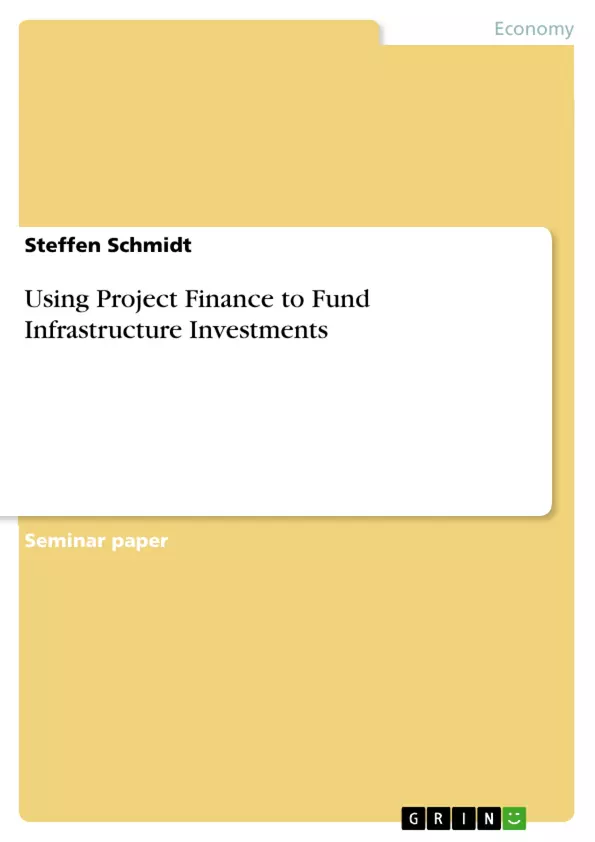The competitiveness and the ability of economic growth and the local living standards are closely related to a country’s infrastructure quality and volume. After World War II, in Europe huge investments in infrastructure, such as roads, railways or hospitals were traditionally financed by public sources, such as tax revenues, over-printing of money or borrowings. Today, especially in the developing countries there is a huge demand for infrastructure investments.
There exist so-called “infrastructure gaps”: In order to improve the standard of living and the attractiveness of a country and econ-omy, the segments of transport, electricity generation, transmission as well as water and telecommunications are essential. The main problem for governments is that Infrastructure projects within these segments usually have a huge extent and require a lot of capital, which often is not available. The OECD estimates that there exists a global infrastructure investment requirement of 71 trillion dollars by the year 2030 only to improve the basic infrastructure. But also in Europe there is an important demand for infrastructure investments. Today, post financial crisis, the TEN-T pro-gram which started in 2014 and also the energy distribution networks or the power plants will require very huge amounts of capital in the coming years and decades, while the political and economic situation is rather uncertain.
The forms of financing projects like the above mentioned have changed substantially: Over the past years and decades, severe budget constraints and inefficient manage-ment of infrastructure projects by public entities have led to an increased involvement of private investors in the business of infrastructure financing. This development has attached more and more importance to concrete strategies of private financing forms or partnerships. In recent years this private funding has increasingly taken the form of project finance. So there are basically the following questions: What exactly is project finance, how can a partnership between a public and a private entity be es-tablished and how can this construct help to solve the problem of the mentioned infrastructure gap? The scope of project finance, the different forms and the critical success factors and the meaning for infrastructure finance are the subject of this assignment.
Inhaltsverzeichnis (Table of Contents)
- 1. Introduction
- 1.1 Objective of this work
- 2. Definitions
- 2.1 Definition of Infrastructure Investments
- 2.2 Definition of project finance
- 2.2.1 PPP Arrangements
- 3. Project Finance
- 3.1 Principles of project finance
- 3.2 Importance and difficulties of project finance
- 4. The construct of project finance
- 4.1 The main parties involved
- 4.2 Contractual framework in project finance
- 5. Conclusions
Zielsetzung und Themenschwerpunkte (Objectives and Key Themes)
This term paper aims to provide an in-depth analysis of project finance as a funding mechanism, with a particular emphasis on infrastructure investments. It seeks to identify and explain the key actors, mechanisms, and diverse sources of capital involved in project finance. The paper will further analyze the risks and opportunities associated with project finance, underscoring the importance of a robust contractual framework in facilitating successful projects.
- The nature and scope of project finance
- The role of project finance in infrastructure investments
- The key parties involved in project finance
- The importance of a sound contractual framework in project finance
- The challenges and opportunities associated with project finance
Zusammenfassung der Kapitel (Chapter Summaries)
- Chapter 1: Introduction
This introductory chapter sets the stage by highlighting the crucial link between infrastructure quality and economic growth. It underscores the increasing demand for infrastructure investments, particularly in developing countries, and notes the challenges posed by the substantial capital requirements. The chapter further discusses the evolving landscape of infrastructure financing, highlighting the shift towards private involvement and the growing importance of project finance.
- Chapter 2: Definitions
This chapter provides a clear understanding of the key terms related to the scope of the paper. It defines "Infrastructure Investments" and "Project Finance," exploring the various forms of infrastructure financing and presenting a detailed overview of project finance, including public-private partnerships (PPPs).
- Chapter 3: Project Finance
This chapter delves into the core aspects of project finance, outlining its fundamental principles, importance, and associated difficulties. It explores the role of project finance in addressing the challenges of infrastructure investments and discusses the rationale behind its increasing popularity.
- Chapter 4: The Construct of Project Finance
This chapter examines the intricate structure of project finance, focusing on the main parties involved in the financing process. It sheds light on the contractual framework that underpins project finance, outlining its essential components and their role in ensuring successful project execution.
Schlüsselwörter (Keywords)
The primary focus of this term paper revolves around the utilization of project finance to address the funding needs of infrastructure investments. Key terms and concepts include infrastructure finance, project finance, public-private partnerships (PPPs), contractual framework, risk assessment, and capital mobilization. The paper aims to provide a comprehensive analysis of these concepts and their practical implications for infrastructure development.
- Quote paper
- Steffen Schmidt (Author), 2015, Using Project Finance to Fund Infrastructure Investments, Munich, GRIN Verlag, https://www.grin.com/document/338315



